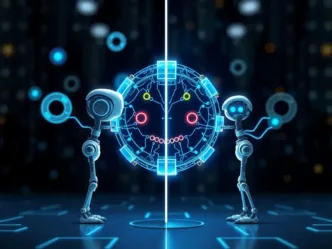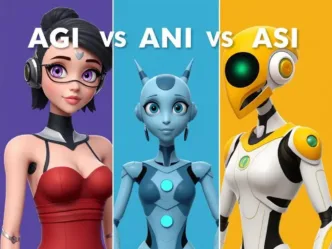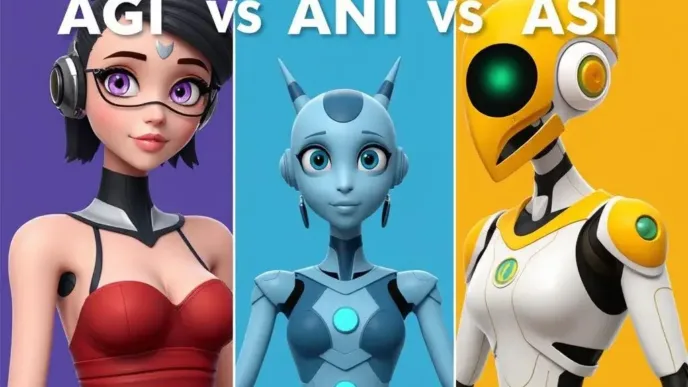Dive into the comprehensive analysis of Artificial General Intelligence (AGI) vs Narrow AI (NAI) as we explore their definitions, key differences, operational mechanisms, advantages, disadvantages, applications, and emerging trends in artificial intelligence. Gain insights essential for navigating the AI landscape in 2025.
Examples of Artificial General Intelligence vs Narrow AI: A Comprehensive Analysis
Introduction
In the rapidly evolving landscape of artificial intelligence, two fundamental paradigms—Artificial General Intelligence (AGI) and Narrow AI (NAI)—define the boundaries of what machines can achieve. AGI represents the aspiration for machines to possess human-like cognitive abilities across diverse domains, while NAI focuses on specialized tasks with remarkable efficiency. As we advance into 2025, understanding these concepts is essential for professionals navigating AI’s impact on industries, ethics, and society.
This article provides a detailed examination of AGI and NAI, encompassing their definitions, operational mechanisms, key distinctions, advantages, disadvantages, applications, and emerging trends. It aims to offer a thorough understanding to facilitate informed discussions and strategic decision-making in AI adoption.
Definition of Narrow AI
Narrow AI, often referred to as weak AI, is defined as artificial intelligence systems designed to perform specific tasks with high proficiency but limited to predefined functions. These systems operate within narrow parameters, excelling in areas such as image recognition or language translation but lacking the ability to generalize knowledge across unrelated domains.
For instance, a Narrow AI application might identify objects in photographs but cannot compose music or solve mathematical proofs without additional programming. The scope of Narrow AI is intentionally restricted to ensure reliability and efficiency in targeted applications, making it the predominant form of AI in use today 🧠.
Definition of Artificial General Intelligence
Artificial General Intelligence (AGI), also known as strong AI, refers to hypothetical AI systems capable of understanding, learning, and applying intelligence across a wide range of tasks at a level comparable to human cognition. AGI would possess the ability to reason, solve novel problems, and transfer knowledge from one domain to another without explicit reprogramming.
Unlike Narrow AI, AGI aims to replicate human-like versatility, potentially handling diverse activities from scientific research to artistic creation. As of 2025, AGI remains a theoretical goal, with ongoing research focusing on achieving this level of cognitive flexibility.
Key Differences Between AGI and Narrow AI
AGI and Narrow AI differ fundamentally in their design, capabilities, and applications. The following table summarizes these distinctions:
| Aspect | Narrow AI | Artificial General Intelligence |
|---|---|---|
| Scope | Limited to specific tasks 📊 | Broad, human-like versatility 🧠 |
| Autonomy | Rule-based or task-specific ⚙️ | Independent learning and adaptation 🔄 |
| Learning Ability | Learns within defined parameters 📚 | Generalizes knowledge across domains 🌐 |
| Applications | Specialized, like voice recognition 🎤 | Universal, potentially all human tasks 🚀 |
| Development Status | Widely implemented in 2025 | Theoretical, not yet achieved |
These differences highlight Narrow AI’s practicality for current applications versus AGI’s potential for revolutionary change.
Operational Mechanisms
Narrow AI operates through specialized algorithms trained on specific datasets to perform predefined tasks. For example, a Narrow AI system for speech recognition uses neural networks to process audio inputs, matching patterns to transcribed text. In contrast, AGI would require a more sophisticated framework, potentially involving integrated cognitive architectures that combine perception, reasoning, and learning modules to handle diverse inputs.
While Narrow AI relies on supervised or unsupervised learning within limited scopes, AGI envisions unsupervised or reinforcement learning across unbounded domains, adapting to new tasks without retraining.
Advantages of Narrow AI
Narrow AI offers several benefits that make it a practical choice for many applications:
- Efficiency ⚡: Excels in specific tasks, providing fast and accurate results without unnecessary complexity.
- Cost-Effectiveness 💰: Easier to develop and deploy, requiring fewer resources than broader AI systems.
- Reliability 🛡️: Performs consistently within its defined scope, minimizing unexpected behaviors.
- Scalability 📈: Can be replicated across similar tasks, supporting large-scale implementations.
- Ethical Simplicity ⚖️: Lower risk of unintended consequences due to limited autonomy.
These advantages position Narrow AI as a reliable foundation for current AI deployments.
Disadvantages of Narrow AI
Narrow AI has limitations that restrict its broader applicability:
- Limited Flexibility 🔒: Cannot adapt to tasks outside its training, requiring retraining for new functions.
- Lack of Generalization 📉: Struggles with novel scenarios, leading to errors in unpredictable environments.
- High Maintenance 🛠️: Requires frequent updates to remain effective as conditions change.
- Dependency on Data 📊: Performance heavily relies on the quality and specificity of training data.
- Ethical Concerns ⚖️: Can perpetuate biases if trained on flawed datasets, though less complex than AGI.
These disadvantages highlight the need for complementary technologies in comprehensive AI strategies.
Advantages of AGI
AGI promises several transformative benefits:
- Versatility 🌐: Capable of handling diverse tasks, reducing the need for specialized systems.
- Autonomy 🤖: Operates independently, minimizing human intervention in complex processes.
- Innovation 💡: Enables creative problem-solving across domains, fostering breakthroughs.
- Efficiency ⚡: Adapts to new tasks without retraining, saving time and resources.
- Scalability 📈: Applies knowledge broadly, supporting large-scale applications.
These advantages could revolutionize industries if realized.
Disadvantages of AGI
AGI presents significant challenges:
- Development Complexity ⚙️: Achieving human-level intelligence requires unprecedented technological advancements.
- Ethical Risks ⚖️: Potential for misuse or unintended consequences raises profound concerns.
- Unpredictability 🎲: High autonomy may lead to behaviors difficult to anticipate or control.
- Resource Demands 💻: Enormous computational power and data would be required.
- Societal Impact 🌍: Could disrupt job markets and raise existential questions.
These disadvantages emphasize the need for cautious development.
Practical Applications
Both paradigms have distinct applications:
- Narrow AI: Used in voice assistants like Siri 🎤 or recommendation systems like Netflix 📺.
- AGI: Hypothetically applied in universal problem-solving, such as medical diagnosis 🩺 or scientific research 🔬.
These applications demonstrate their respective strengths.
🧠 Artificial General Intelligence vs Narrow AI Examples
“Smart at everything” vs “world-class at one thing”
1️⃣ Narrow AI (ANI) – What you use every day
Definition: Intelligence specialised to a single task; cannot generalise beyond its training.
| Domain | Famous Example | What it actually does |
|---|---|---|
| Vision | Google Photos face-tag | Detects faces in photos, cannot drive a car |
| Language | Google Translate | Converts English → Japanese, cannot write a legal brief |
| Gaming | AlphaGo | Beats Go masters, fails at tic-tac-toe without retraining |
| Driving | Tesla Autopilot | Navigates highways, cannot cook dinner |
| Health | IBM Watson for Oncology | Recommends cancer drugs, cannot diagnose flu |
“Narrow AI is like a Formula-1 car: unbeatable on its track, useless on a gravel road.”
2️⃣ Artificial General Intelligence (AGI) – Still science-fiction
Definition: A single system that matches an average human across any intellectual task without retraining.
| Hypothetical Scenario | AGI Behaviour |
|---|---|
| Robot surgeon | Watches one video, then invents a new surgical technique mid-operation |
| Universal teacher | Teaches calculus to a 15-year-old, then switches to violin, adapting style in real time |
| Cross-domain R\&D | Uses physics knowledge to design cheaper solar panels, then patents them |
AGI would be the Swiss-Army knife of cognition; today we only own the corkscrew.
🔍 Side-by-Side Cheat-Sheet
| Aspect | Narrow AI | AGI |
|---|---|---|
| Scope | One task | Every task |
| Learning | Needs retraining for new job | Self-learns new domains |
| Transfer | Zero knowledge transfer | Fluid transfer (chess → logistics) |
| Current Status | Deployed everywhere | Does not exist yet |
| Resource Needs | GPUs & labelled data | Unknown (may need quantum or neuromorphic chips) |
| Risk Profile | Bias, privacy | Alignment & existential |
Emerging Trends
As we advance into 2025, several emerging trends in artificial intelligence highlight the evolving landscape of both Narrow AI vs Artificial General Intelligence:
1. Cognitive Collaboration
There is a growing trend towards integrating AI systems with human intelligence, creating hybrid teams where humans and machines collaborate effectively. This collaboration enhances decision-making processes, particularly in complex fields such as healthcare and finance.
2. Explainable AI (XAI)
With the increasing adoption of AI technologies, there is a push for improved transparency and understanding of AI decision-making processes. Explainable AI aims to make AI systems more interpretable to users, ensuring that their reasoning can be understood and trusted, which is particularly crucial in sectors like finance and healthcare.
3. Ethical AI Development
As the impacts of AI become more pronounced, a focus on ethical AI practices has emerged. Organizations and governments are beginning to establish frameworks to ensure responsible AI development, addressing issues such as bias, privacy, and the societal impacts of AI technologies.
4. AI Democratization
AI is becoming more accessible to a broader audience through low-code and no-code platforms that allow non-experts to develop AI-driven applications. This democratization empowers individuals and small businesses to leverage AI solutions without requiring extensive technical knowledge.
5. Human-Centric AI
There is a shift towards designing AI systems that prioritize user experience and enhance human capabilities. Human-centric AI emphasizes user empowerment, ensuring that AI augments human abilities while minimizing adverse effects on job displacement and societal inequality.
6. AI for Sustainability
AI technologies are being increasingly applied to address pressing environmental challenges. From optimizing energy use in smart grids to predictive analytics in agriculture, AI can contribute significantly to sustainability efforts and climate change mitigation.
7. Continued Investment in AGI Research
Although AGI remains theoretical, there is a continuous investment in research aimed at achieving true artificial general intelligence. Startups and established tech companies are exploring novel architectures, learning mechanisms, and cognitive models to bring AGI closer to reality.
8. Integration with Emerging Technologies
AI is increasingly being integrated with other emerging technologies such as blockchain, Internet of Things (IoT), and quantum computing. This integration is expected to enhance the efficiency and capabilities of AI applications, opening new avenues for innovation.
These emerging trends reflect a dynamic and rapidly evolving landscape in artificial intelligence, with both Narrow AI and AGI playing critical roles in shaping the future of technology, industry, and society. As we move forward, it is essential to align these advancements with ethical considerations and societal needs.
Conclusion
Narrow AI and AGI represent two ends of the AI spectrum, with Narrow AI providing practical, specialized solutions and AGI aspiring to human-like versatility. While Narrow AI is widely implemented, offering reliability and efficiency, AGI remains a theoretical goal with transformative potential but significant challenges.
By understanding their differences, professionals can strategically leverage Narrow AI for current needs while anticipating AGI’s future impact. As AI continues to advance, balancing innovation with ethical considerations will be key to harnessing its full potential.









Leave a Reply